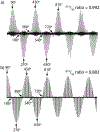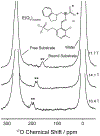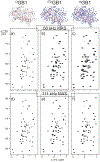Advances in instrumentation and methodology for solid-state NMR of biological assemblies
- PMID: 30205196
- PMCID: PMC6408314
- DOI: 10.1016/j.jsb.2018.09.003
Advances in instrumentation and methodology for solid-state NMR of biological assemblies
Abstract
Many advances in instrumentation and methodology have furthered the use of solid-state NMR as a technique for determining the structures and studying the dynamics of molecules involved in complex biological assemblies. Solid-state NMR does not require large crystals, has no inherent size limit, and with appropriate isotopic labeling schemes, supports solving one component of a complex assembly at a time. It is complementary to cryo-EM, in that it provides local, atomic-level detail that can be modeled into larger-scale structures. This review focuses on the development of high-field MAS instrumentation and methodology; including probe design, benchmarking strategies, labeling schemes, and experiments that enable the use of quadrupolar nuclei in biomolecular NMR. Current challenges facing solid-state NMR of biological assemblies and new directions in this dynamic research area are also discussed.
Keywords: Biological assemblies; Instrumentation; MAS probe; Magic angle spinning; Solid-state NMR.
Copyright © 2018 Elsevier Inc. All rights reserved.
Figures










Similar articles
-
Protein structure determination with paramagnetic solid-state NMR spectroscopy.Acc Chem Res. 2013 Sep 17;46(9):2117-26. doi: 10.1021/ar300360q. Epub 2013 Mar 6. Acc Chem Res. 2013. PMID: 23464364
-
Solid-state NMR: An emerging technique in structural biology of self-assemblies.Biophys Chem. 2016 Mar;210:14-26. doi: 10.1016/j.bpc.2015.07.003. Epub 2015 Jul 16. Biophys Chem. 2016. PMID: 26234527
-
Solid-state NMR spectroscopy of proteins.Top Curr Chem. 2013;335:121-56. doi: 10.1007/128_2012_417. Top Curr Chem. 2013. PMID: 23504090 Review.
-
Proton-Based Ultrafast Magic Angle Spinning Solid-State NMR Spectroscopy.Acc Chem Res. 2017 Apr 18;50(4):1105-1113. doi: 10.1021/acs.accounts.7b00082. Epub 2017 Mar 29. Acc Chem Res. 2017. PMID: 28353338 Free PMC article. Review.
-
Structure determination of supra-molecular assemblies by solid-state NMR: Practical considerations.Prog Nucl Magn Reson Spectrosc. 2018 Dec;109:51-78. doi: 10.1016/j.pnmrs.2018.06.002. Epub 2018 Jun 18. Prog Nucl Magn Reson Spectrosc. 2018. PMID: 30527136 Review.
Cited by
-
Carbohydrate-aromatic interface and molecular architecture of lignocellulose.Nat Commun. 2022 Jan 27;13(1):538. doi: 10.1038/s41467-022-28165-3. Nat Commun. 2022. PMID: 35087039 Free PMC article.
-
Structures of Pathological and Functional Amyloids and Prions, a Solid-State NMR Perspective.Front Mol Neurosci. 2021 Jul 1;14:670513. doi: 10.3389/fnmol.2021.670513. eCollection 2021. Front Mol Neurosci. 2021. PMID: 34276304 Free PMC article. Review.
-
Recent Advances in Amyloids Structural Studies and Thin Film Applications.Molecules. 2025 Jul 9;30(14):2908. doi: 10.3390/molecules30142908. Molecules. 2025. PMID: 40733175 Free PMC article. Review.
-
Segmental Dynamics of Membranous Cholesterol are Coupled.J Am Chem Soc. 2023 Jul 19;145(28):15043-15048. doi: 10.1021/jacs.3c01775. Epub 2023 Jul 6. J Am Chem Soc. 2023. PMID: 37410392 Free PMC article.
-
Chemical Properties Determine Solubility and Stability in βγ-Crystallins of the Eye Lens.Chembiochem. 2021 Apr 16;22(8):1329-1346. doi: 10.1002/cbic.202000739. Epub 2021 Feb 10. Chembiochem. 2021. PMID: 33569867 Free PMC article. Review.
References
-
- Fricke P, Chevelkov V, Shi C, Lange A, Strategies for solid-state NMR investigations of supramolecular assemblies with large subunit sizes, Journal of Magnetic Resonance 253 (2015) 2–9. - PubMed
-
- Marvin D, Symmons M, Straus S, Structure and assembly of filamentous bacteriophages, Progress in Biophysics and Molecular Biology 114 (2014) 80–122. - PubMed
-
- Han Y, Hou G, Suiter CL, Ahn J, Byeon I-JL, Lipton AS, Burton S, Hung I, Gorkov PL, Gan Z, Brey W, Rice D, Gronenborn AM, Polenova T, Magic angle spinning NMR reveals sequence-dependent structural plasticity, dynamics, and the spacer peptide 1 conformation in HIV1 capsid protein assemblies, Journal of the American Chemical Society 135 (2013) 17793–17803. - PMC - PubMed
Publication types
MeSH terms
Substances
Grants and funding
LinkOut - more resources
Full Text Sources
Other Literature Sources

